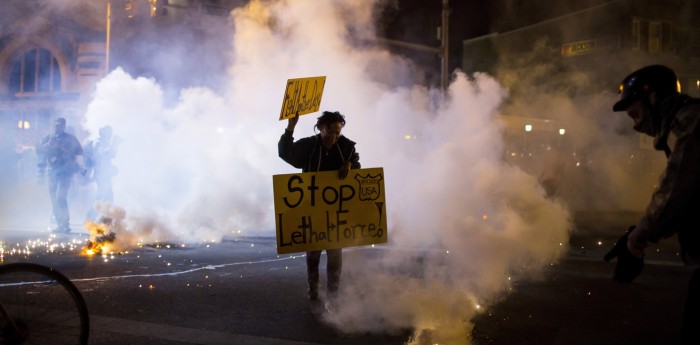Before implementing a citywide curfew aimed at alleviating the violence that erupted in Baltimore on April 27, the city’s Mayor Stephanie Rawlings-Blake said, “It is very clear there is a difference between what we saw over the past week with the peaceful protests […] and the thugs who only want to incite violence and destroy our city.” During a press conference, U.S. President Barack Obama also condemned the “thugs” who had been ransacking the city.
Rawlings-Blake has since apologized for referring to the protesters as thugs, claiming in a tweet that she used the word out of frustration and did not mean it. Multiple activists joined in condemning the use of the word, including Questlove, Baltimore City Councilman Carl Stokes, and Reverend Jamal Bryant. Stokes went on to argue that “thug” is the new n-word.
I wanted to clarify my comments on "thugs." When you speak out of frustration and anger, one can say things in a way that you don't mean.
— Mayor Rawlings-Blake (@MayorSRB) April 29, 2015
As with the Ferguson protests, peaceful demonstrations in Baltimore turned violent when local police responded defensively and armed with military grade weapons; the presence of riot gear and SWAT cars is enough to put anyone on edge. Images such as the photos of a burning police car or looters running out of a CVS have been widely circulated. The media has an undeniable weak spot for urban scenes marred by a smoky haze and interrupted by the silhouette of a man with a bandana over his face. These images of rioting are the most prevalent, the most eye-catching, and the most effective at influencing the public’s view of what is occurring in Baltimore. By promoting these images, the media has effectively allowed vitriol concerning the acceptability of rioting to overshadow the goals of the peaceful protestors.
Referring to the Baltimore rioters as “thugs” removes all legitimacy from the protesters’ cause. It brands the rioters as people who seek only to destroy and cause grievances, denying their rationality, their frustration, and the motivations behind their actions. By saying there is no excuse for the escalation of the protests, the media portrays the excuse they have—that police are unnecessarily aggressive and not held accountable for their actions—as not enough.
[URIS id=35056]
This is not to justify the rioting in Baltimore, only to shed light on the fact that anger manifests itself in multiple ways; dismissing part of what transpired in Baltimore as petty and disgraceful discredits the entirety of the situation. As the media conflated the protesters’ cause with the aggression of the riots, their grievances were muted.
It is necessary to note that “thug” is not a blanket term for rioters; it has been overwhelmingly linked to race. Protesters in Baltimore confronted police injustice, while the Ferguson protesters reacted against racial discrimination. Yet, the media referred to groups and individuals in each situation as thugs—something they had also done with Michael Brown, Trayvon Martin, and Eric Garner.
On the other hand, the predominantly white Penn State University students who tore down light poles and flipped over broadcast vans in reaction to the firing of former Penn State Head Football Coach Joe Paterno were described as “upset” by the New York Times. During the 2014 World Series riots in San Francisco, the initial celebrations culminated in the injury of three people, two from gunshots and a third from a stabbing, as well as widespread arson throughout the city. One media outlet described the rioters as “rowdy,” and focused more on the excitement following the victory rather than the extensive damage caused by the riots.
In reflecting on the Baltimore riots and its impacts, another issue has emerged. Many columnists from primarily conservative blogs have justified the use of the term “thug” by saying it only applies to a certain type of person, one who riots for his or her own gain and is separate from those protesting for change and reform. While this claim is appropriate in its condemnation of the violence, the consequent overshadowing of the widespread oppression and physical and judicial mistreatment of African-Americans by the police is a further injustice.
The protests have been over for almost a fortnight, and the media has moved on to more pressing matters, such as the truth behind deflategate. However, considering the ongoing trend of racial injustice and police brutality in the United States—which found some justice following State Attorney Marilyn Mosby’s charge of six officers with Gray’s death—protests are likely to continue and increase as frustration grows. Rising emotions will inevitably lead to unmitigated outbursts by outliers, but while representing these events the media must elucidate, not shroud, the underlying cause for protest and riots. When taking a stand against systemic discrimination and marginalization, the average protester is not overreacting. They are activists fighting for change—they deserve to be referred to as such.








